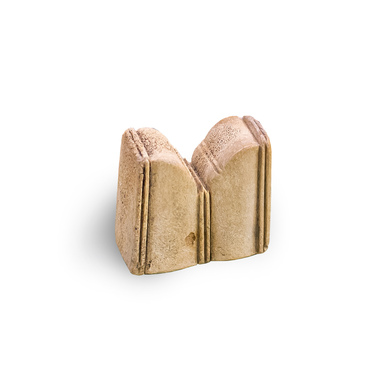Bow and arrows are the oldest weapons of man. The tribes, using a bow, repelled the enemy’s attack or hunted cautious animals that were difficult or dangerous to fight in close combat.
The bow was made from an ash or teak branch, and the arrows were made from smooth shoots of any tree species. The bowshot depended on the bow design, the string tension, and the weather; on average, a person could hit a target at a distance of up to 250 meters. Over time, along with these weapons, archers began to wear protective equipment.
Archaeologists have found several bone objects from the armament of a rich equestrian warrior and an archer on a Bolgar ancient settlement. These items are among the rare finds in medieval antiquities of Eastern Europe. They are executed at a high artistic level and are perfectly preserved. All items were found not far from each other — on the southwestern outskirts of the pre-Mongol Bolgar, which became the central district of the city in the Golden Horde period. These exhibits are kept in the collection of the Bolgar State Historical and Architectural Museum-Reserve.
Archaeologists found an oval-shaped bone curved plate in 1980. Such accessories protected the archer’s left wrist from the bowstring strike. There are two pairs of holes are visible in the middle part of the plate, through which the straps were threaded: they attached the plate to the arm. The holes edges and the distances between the paired holes have traces of scuffing from leather ties. Bulgars carefully polished the surface adjacent to the hand, as well as the edges. The outer surface of the plate was decorated with an ornament. It was made up of a two-tiered narrow strip along the edge and a belt in the middle part. The outer tier is filled with repeating S-shaped figures with short tails extending from it. A geometric pattern similar to a meander is visible on the inner tier.
A meander was referred to a kind of geometric ornament, where the pattern is formed by a line broken at right angles or spiral curls. The ornament was also engraved in the so-called ‘technique of grooved triangles’. In this technique, small details seemed to be ‘pinched off’ the bone.
The bow was made from an ash or teak branch, and the arrows were made from smooth shoots of any tree species. The bowshot depended on the bow design, the string tension, and the weather; on average, a person could hit a target at a distance of up to 250 meters. Over time, along with these weapons, archers began to wear protective equipment.
Archaeologists have found several bone objects from the armament of a rich equestrian warrior and an archer on a Bolgar ancient settlement. These items are among the rare finds in medieval antiquities of Eastern Europe. They are executed at a high artistic level and are perfectly preserved. All items were found not far from each other — on the southwestern outskirts of the pre-Mongol Bolgar, which became the central district of the city in the Golden Horde period. These exhibits are kept in the collection of the Bolgar State Historical and Architectural Museum-Reserve.
Archaeologists found an oval-shaped bone curved plate in 1980. Such accessories protected the archer’s left wrist from the bowstring strike. There are two pairs of holes are visible in the middle part of the plate, through which the straps were threaded: they attached the plate to the arm. The holes edges and the distances between the paired holes have traces of scuffing from leather ties. Bulgars carefully polished the surface adjacent to the hand, as well as the edges. The outer surface of the plate was decorated with an ornament. It was made up of a two-tiered narrow strip along the edge and a belt in the middle part. The outer tier is filled with repeating S-shaped figures with short tails extending from it. A geometric pattern similar to a meander is visible on the inner tier.
A meander was referred to a kind of geometric ornament, where the pattern is formed by a line broken at right angles or spiral curls. The ornament was also engraved in the so-called ‘technique of grooved triangles’. In this technique, small details seemed to be ‘pinched off’ the bone.


